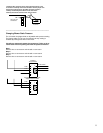
3
Before Getting Started
Caution:
• Do not install the unit where combustible gas may leak.
− If the gas leaks and accumulates around the unit, an
explosion may result.
• Do not use the air conditioner in special environments.
− Oil, steam, sulfuric smoke, etc. can significantly reduce the
performance of the air conditioner or damage its parts
.
• When installing the unit in a hospital, communication
station, or similar place, provide sufficient protection
against noise.
− The inverter equipment, private power generator, high-
frequency medical equipment, or radio communication
equipment may cause the air conditioner to operate
erroneously, or fail to operate. On the other hand, the air
conditioner may affect such equipment by creating noise
that disturbs medical treatment of image broadcasting.
• Do not install the unit on a structure that may cause
leakage.
− When the room humidity exceeds 80% or when the drain
pipe is clogged, condensation may drip from the indoor unit.
Perform collective drainage work together with the outdoor
unit, as required.
Before getting installed (moved)-electrical work
Caution:
• Ground the unit.
− Do not connect the ground wire to gas or water pipes,
lightning rods, or telephone ground lines. Improper
grounding may result in electric shock.
• Install the power cable so that tension is not applied to
the cable.
− Tension may cause the cable to break and generate heat
and cause a fire.
• Use power line cables of sufficient current carrying
capacity and rating.
− Cables that are too small may leak, generate heat, and
cause a fire.
• Use only a circuit breaker and fuse of the specified
capacity.
− A fuse or circuit breaker of a larger capacity or a steel or
copper wire may result in a general unit failure or fire.
• Do not wash the air conditioner units.
− Washing them may cause an electric shock.
• Be careful that the installation base is not damaged by
long use.
− If the damage is left uncorrected, the unit may fall and
cause personal injury or property damage.
• Install the drain piping according to this Installation
Manual to ensure proper drainage. Wrap thermal
insulation around the pipes to prevent condensation.
−
Improper drain piping may cause water leakage and
damage to furniture and other possessions.
• Be very careful about product transportation
− If the product weighs more than 20 kg [44 lb], then more
than one person should carry the product.
− Some products use PP bands for packaging. Do not use
any PP bands for a means of transportation; it is dangerous.
− Do not touch the heat exchanger fins. Doing so may cut
your fingers.
• Safely dispose of the packing materials.
− Packing materials, such as nails and other metal or wooden
parts, may cause stabs or other injuries.
− Tear apart and throw away plastic packaging bags so that
children will not play with them. If children play with a
plastic bag which was not torn apart, they face the risk of
suffocation.
Before Starting the test run
Caution:
• Turn on the power at least 12 hours before starting
operation.
− Starting operation immediately after turning on the main
power switch can result in severe damage to internal
parts. Keep the power switch turned on during the
operational season.
• Do not touch the switches with wet fingers.
− Touching a switch with wet fingers can cause electric
shock.
• Do not touch the refrigerant pipes during and
immediately after operation.
− During and immediately after operation, the refrigerant
pipes may be hot or may be cold, depending on the
condition of the refrigerant flowing through the refrigerant
piping, compressor, and other refrigerant cycle parts.
Your hands may suffer burns or frostbite if you touch the
refrigerant pipes.
• Do not operate the air conditioner with the panels and
guards removed.
− Rotating, hot, or high-voltage parts can cause injuries.
• Do not turn off the power immediately after stopping
operation.
− Always wait at least five minutes before turning off the
power. Otherwise, water leakage and trouble may occur.
SELECTING AN INSTALLATION SITE
• Avoid locations exposed to outside air.
• Select a location free of obstructions to the airflow in and out
of the unit.
• Avoid locations exposed to steam or vapor
• Avoid locations where combustible gas may leak, settle or be
generated.
• Avoid installation near machines emitting high-frequency
waves (high frequency welders, etc.).
• Avoid locations where the airflow is directed at a fire alarm
sensor. (Hot air could trigger the alarm during operation)
• Avoid places where acidic solutions are frequently used.
• Avoid places where sulphur-based or other sprays are
commonly used.
• If the unit is run for long hours when the air surrounding the
unit is a high temperature/high humidity (dew point above
80
o
F, dew condensation may be produced on the unit. When
operating the units in this condition, add insulation material
(13/32 – 13/16 in) to the entire surface of the unit to avoid
condensation.
INSTALLING THE UNIT
The air handler can be installed in a vertical or horizontal (left
only) configuration as shown below. The units are designed for “0”
zero clearance to combustibles. 24” is required for service access
to the front of the unit. (See below) Regardless of mounting
configuration, the air handler must be mounted level to facilitate
proper condensate drainage.










